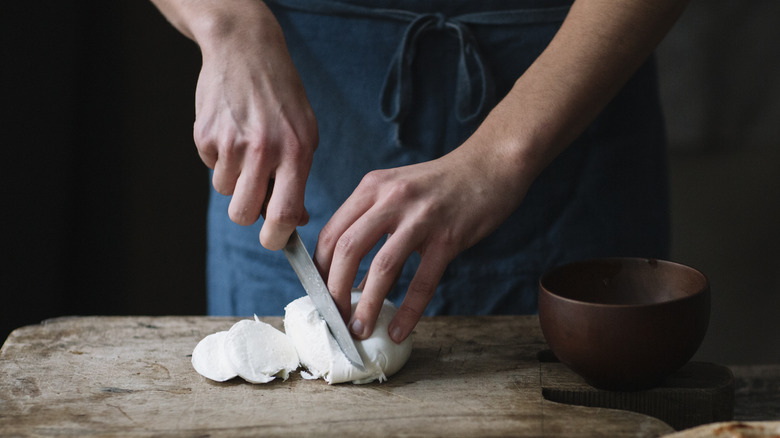The Healthiest Cheese To Eat If You Have High Blood Pressure
High blood pressure isn't something you want to ignore. Left unchecked, high blood pressure (aka hypertension) can lead to a host of serious medical issues, from hardening of the arteries to brain damage. That's one reason to choose the foods you eat carefully. And if you're a cheese fanatic, you might assume you have to give up one of your favorite foods. Not so, fortunately: You just have to pick a blood pressure-friendly cheese option, such as mozzarella.
What makes mozzerella a smarter choice if you struggle with hypertension? Jana Greene Hand, MS, RD, founder of Helping Hand Nutrition, has the answer: It's low in salt and packed with nutrition. As Hand explains, "Mozzarella has less than half the sodium of feta and parmesan cheese and is lower in sodium than most other cheeses. Too much sodium in the diet can lead to high blood pressure, water retention, heart disease, and kidney disease." She adds that "mozzarella is rich in potassium, which helps balance sodium in the body and relax blood vessel walls." Plus, Hand mentions that mozzarella cheese brings a respectable amount of protein and calcium to any dish.
The link between sodium and blood pressure
Where does mozzarella stand, sodium-wise? The U.S. Department of Agriculture (USDA) shows that 100 grams of whole milk mozzarella contains 486 milligrams of sodium. By comparison, the USDA indicates that the same serving size of feta cheese brings along 1,140 milligrams of sodium. Given that the U.S. Food and Drug Administration recommends that most adults limit their sodium intake to 2,300 milligrams daily, mozzarella is clearly the better option.
Let's go a little farther into the problematic connection between sodium and hypertension. Per the American Heart Association, eating an abundance of salt forces the blood vessels to constrict. This in turn causes the heart to pump harder to move the blood throughout the body. The result for some people? Higher blood pressure readings — and an elevated risk of developing cardiovascular disease. Fortunately, cutting back on sodium by eating lower-sodium foods like mozzarella can reduce some of those risks. In a 2023 study published in JAMA, researchers concluded that reducing sodium for just a week could have a significant effect on blood pressure. In fact, the effect was equally as pronounced as the effect of a common blood pressure lowering medication.
Calcium as blood pressure regulator
In addition to mozzarella cheese falling in the lower sodium range of cheese, it brings another hypertension-fighting tool with every bite: calcium. Healthline data reveals that you can expect to get 11% of the daily recommended value of calcium (for someone following a 2000-calorie diet) with each ounce of mozzarella you enjoy. That's a big deal because calcium is a nutrient that's recognized for its blood pressure management abilities.
A 2022 article in the Cochrane Database of Systematic Reviews looked at the effectiveness of calcium to lower blood pressure. The authors came to the conclusion that an increase in calcium could have a preventative effect on future hypertension in those with normal blood pressure. This doesn't mean you should augment the calcium in your mozzarella (or overall diet) with tons of calcium supplements, though. Amanda Davis, Pharm.D., R.Ph., advises against overdoing it with your calcium intake, particularly if you're already taking a thiazide diuretic to better control your hypertension (via the Mayo Clinic). Nonetheless, you may be able to slightly increase your calcium even if you take other blood pressure medications. Just take time to speak with your healthcare provider first.
Focus on mozzarella as a heart healthy cheese
It's both convenient and simple to switch to mozzarella cheese. Although mozzarella doesn't taste the same as other cheeses, it's still a lower-sodium, high-calcium substitute that may be better for your blood pressure in the short and long run. Consequently, it may be worth taking the time to use it as a preferred cheese in your dishes. Of course, you can always just eat mozzarella as-is as part of your heart-healthy diet routine. That's even easier and requires less consideration about how mozzarella's flavor or texture might affect a recipe.
In Jana Greene Hand's opinion, one straightforward way to serve plain mozzarella is by making a Caprese salad of mozzarella slices and tomatoes drizzled with olive oil and topped with freshly ground pepper. The registered dietitian also suggests serving fresh mozzarella with roasted sweet peppers, grilled zucchini, or seasonal produce. Or, she says you could go back to basics and "serve [fresh mozzarella] with a lightly toasted baguette and olive oil."



